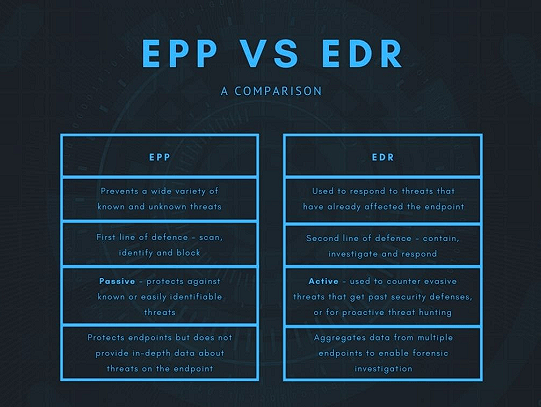Today, your organization is connected to numerous endpoints which get compromised due to ransomware, phishing attack, social engineering, or any other malware attack. Tons of known and unknown threats can disrupt your whole network.
So, when it comes to protecting endpoints, you can find two common solutions: EPP and EDR. Since you can't invest in both solutions, you perform an EPP Vs EDR analysis to find out which one you should choose.
Let's continue reading and learning about both solutions and then compare them to pick the ideal endpoint security solution for your organization.
What is EDR?
It stands for Endpoint detection and response software. It is a comprehensive security option offering real-time visibility into endpoint behavior and activities. This tool can:
- Detect malicious behavior
- Monitor and record data and activities across all endpoints
- Send threat alerts to IT administrators
- Respond to the threat quickly.

The best thing about an endpoint detection tool is that your in-house team can prevent threats proactively by analyzing all the endpoint data.
Today, your endpoints are super vulnerable, and they are becoming a welcoming gateway for threat actors. You are dealing with a wide variety of threats such as Fileless attacks, phishing, and advanced persistent threats (APTs)
EDR Capabilities
These days, an organization can find a wide variety of EDR solutions. As an endpoint security tool is in high demand, more and more companies bring diverse options to choose from.
It is predicted that the global endpoint solution market will reach $18.3 billion by 2031.
Every company offers some unique features. Before you perform EPP Vs EDR analysis, you should know about four basic functionalities that most EDR offers.
Security incident containment
Cybercriminals are quite smart. They don't attack your system during business hours. Most attack ignites during holidays and off days. Now the problem is that your security team can't stay present there all the time. The best solution is to get an EDR that will monitor the endpoints in real time and all the time. As soon as an attack help, the Endpoint tool with block it. It also separates compromised endpoints from other so malicious activities won't spread across the entire network.
Threat detection
It's easy to identify file-based malware with antivirus, as signature-based detection makes this detection pretty simple. But what about fileless malware attacks? It's where Xcitium EDR plays the most important role. It allows your organization to detect malicious activities and attacks - fileless or file-based.
Incident investigation
Your team can easily perform threat investigation and forensics through an Endpoint tool. It keeps a central repository of endpoint data. Thereby, it becomes easy for your team to see where the problem lies in the endpoint and why an attack happened. You can patch system vulnerabilities effectively through this software.
What Is EPP?
It stands for Endpoint Protection Platform, designed to prevent traditional threats like existing malware. Besides, it is effective in dealing with advanced threats such as zero-day exploits, ransomware, and file-less attacks.
EPP Capabilities
You can't easily compare and perform EPP Vs EDR analysis unless you know what this platform can do for you. Here are some common features of EPP
Signature matching
This platform is integrated with signature-based detection technology. If malware attacks your system, this platform checks its code with existing code, and it's how it detects threats using known malware signatures
Sandboxing
It can test the malicious behavior of files by separating them in a virtual environment.
Behavioral analysis
It can analyze the behavior of endpoints and user activities and perform behavior analysis to pinpoint potential threats.
Allow listing and deny listing
You can use this platform to block or permit access to URLs, apps, and specific ID Addresses.
EPP Vs EDR- Which one is the best?
Your organization needs an Endpoint protection platform and an Endpoint Detection and Response tool, especially when employing a holistic endpoint security approach. Fortunately, you can find advanced Endpoint solution such as Xcitium EDR that combines the functionality of both EPP and EDR in one dashboard. Through it, you can actively detect, prevent, and respond to known and unknown threats.
Detection
Regarding threat detection, EPP normally employs signature-based detection and other intrusion indicators to identify known threats. It is usually part of your organization's first line of defense.
EDR software, on the flip side, offers an extra layer of defense. It brings signature-based detection and threat-hunting tools so your organization can deal with all kinds of malware attacks.
Active Investigation
When you want to be proactive with your cyber security approach, a quick EPP Vs EDR analysis tells you that EDR is the solution you need. It requires active supervision from your security team, which can enjoy much visibility into the system through this tool.
However, EPP doesn't need any active supervision at all. Once you configure it, this tool work on its own. You can't use it to investigate an incident like an Endpoint detection and response system.
Threat Prevention
EPP makes it pretty difficult for a threat actor to penetrate your system, but it doesn't prevent threats. Contrary to this, EDR lets you prevent threats and respond to them promptly.
